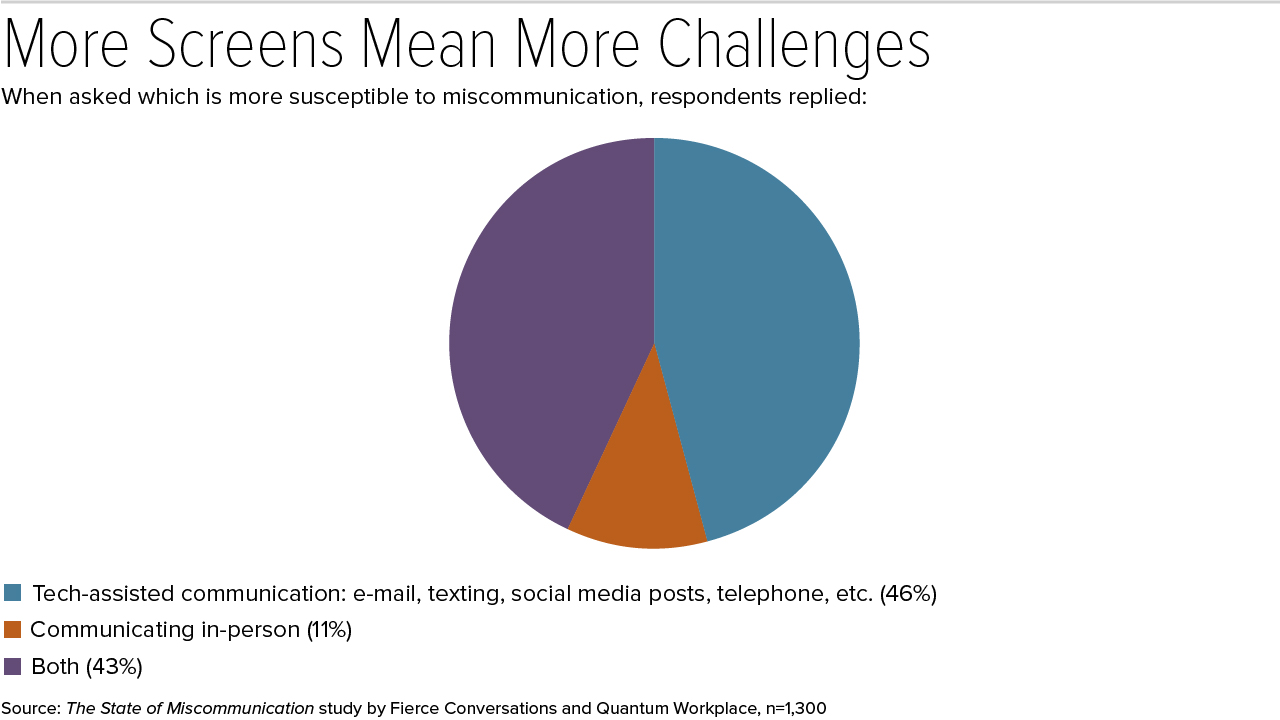Study: Tech Miscommunications May Erode Employee Engagement
Why you should check your tone before pressing 'send'

A new study reveals that although technology has expanded the ways in which we communicate, it has also created opportunities for miscommunication.
And these miscommunications may contribute to a decline in employee engagement.
Seattle-based training company Fierce Conversations and Omaha, Neb.-based employee feedback software company Quantum Workplace surveyed 1,300 people nationwide on how they communicate in the workplace.
When asked which methods of communication are more susceptible to miscommunication:
- 46 percent of respondents said e-mails, texts, telephone conversations, and posts shared to social media and instant messaging platforms.
- 11 percent said communicating in person.
- 43 percent said both.

"Using technology when communicating can offer convenience and save time, but it's important to consider the nature of the communication that needs to take place and whether technology will be an effective channel," the study stated. How to use technology and knowing when to use it are key skills employees must learn to limit miscommunication.
Practice 'Digital Wisdom'
Experts tell SHRM Online that because body language, voice inflection, facial cues and other nuances aren't present in virtual messages, the intent behind digital missives can be easily misconstrued.
"With technology, whether it's e-mail or text, you risk your message being lost in translation," said Sue Scheff, author of Shame Nation: The Global Epidemic of Online Hate (Sourcebooks, 2017). She also told SHRM Online that "what you may believe is a clever or humorous comment could be perceived as cruel or mean on the receiving end."
"It's easy to … read into something that isn't there when communicating via e-mail," said David Bell, CEO of USA Mobile Drug Testing, which provides drug testing services for companies nationwide and is based in Tampa, Fla.
"Because of that, it's critical to invest a little extra time before you hit the 'send' button to make sure your e-mail conveys the exact message you want it to. That may seem like an unnecessary hassle, but in managing 28 franchisees across four time zones, I've found that taking this extra step means I don't have to spend extra time clarifying what I meant or mending hurt feelings after I send an e-mail. Ultimately, it improves efficiency and workplace morale."
It also helps build trust.
"Engaged cultures are those that foster trusting relationships," said Greg Harris, president and CEO at Quantum Workplace. "And trust is the outcome of what we say and how we say it."
[SHRM members-only toolkit: Managing Organizational Communication]
Work/life success coach Marilyn Suttle, CEO of Suttle Enterprises LLC, said that sometimes it's the amount—or lack—of detail in messages that can lead to miscommunication, which is something the survey report points out as well.
"Send e-mails that match the social style of your individual colleagues," Suttle said. "If a colleague tends to send short, concise, bulleted e-mails that get right to the point—do the same. Sending that person a detail-ridden e-mail will aggravate them. Instead, offer to send more details at their request."
Consider your audience. Suttle said that "with group e-mails, resist the urge to call someone out for mistakes they've made. It makes you look unprofessional and inconsiderate to the group. If you have something negative to say, pick up the phone instead."
How you respond to messages may vary depending on the medium, she added. For example, when texting someone, "have good boundaries. Don't make a habit of texting at inappropriate times. Midnight texts send a message, and probably not a very good one."
When chatting, "during webinars … or group Skype calls, create better communication by using the chat box to confirm what's being said—product names, websites, phone numbers, etc., can all be popped into the chat so that your colleagues can cut and paste it for accuracy and reference."
Remember: "Miscommunication breaks down connection and slows productivity. It can lead to loss of trust and lack of professionalism." She said that if there's any confusion, clarify the issue by calling colleagues on the telephone.
The study's authors offer the following tips for using technology to help, rather than hinder, communication.
Use technology if your intention is to:
- Communicate logistics and simple directives.
- Share appreciation and praise.
- Touch base on plans.
- Share a personal epiphany or accomplishment.
- Talk through simple scenarios.
- Summarize a conversation.
Don't use technology if your intention is to:
- Respond to criticism—especially when it's a knee-jerk or emotional response.
- Connect on a deeper level.
- Coach an individual or a team.
- Convey anger or another complex emotion.
- Attack, berate, mock or blame.
- Be confrontational.
- Gossip.
Was this article useful? SHRM offers thousands of tools, templates and other exclusive member benefits, including compliance updates, sample policies, HR expert advice, education discounts, a growing online member community and much more. Join/Renew Now and let SHRM help you work smarter.
An organization run by AI is not a futuristic concept. Such technology is already a part of many workplaces and will continue to shape the labor market and HR. Here's how employers and employees can successfully manage generative AI and other AI-powered systems.



